Business Report on Operations and Project Management for H&M Group
VerifiedAdded on 2023/06/04
|24
|5772
|457
Report
AI Summary
This business report provides a comprehensive analysis of H&M's operations and project management strategies. It begins with an introduction to the company, followed by a discussion of operations versus operations management. The report reviews the implementation of operations management principles, including lean production, mass customization, and flexible specialization, within H&M's context. It then analyzes how H&M's organizational operations management meets key requirements such as cost, quality, and productivity. A continuous improvement plan is presented, describing lean principles and offering recommendations for improvement. The report concludes with suggestions for the scope of improvement at H&M, drawing on the analysis of operations management principles and the continuous improvement plan.
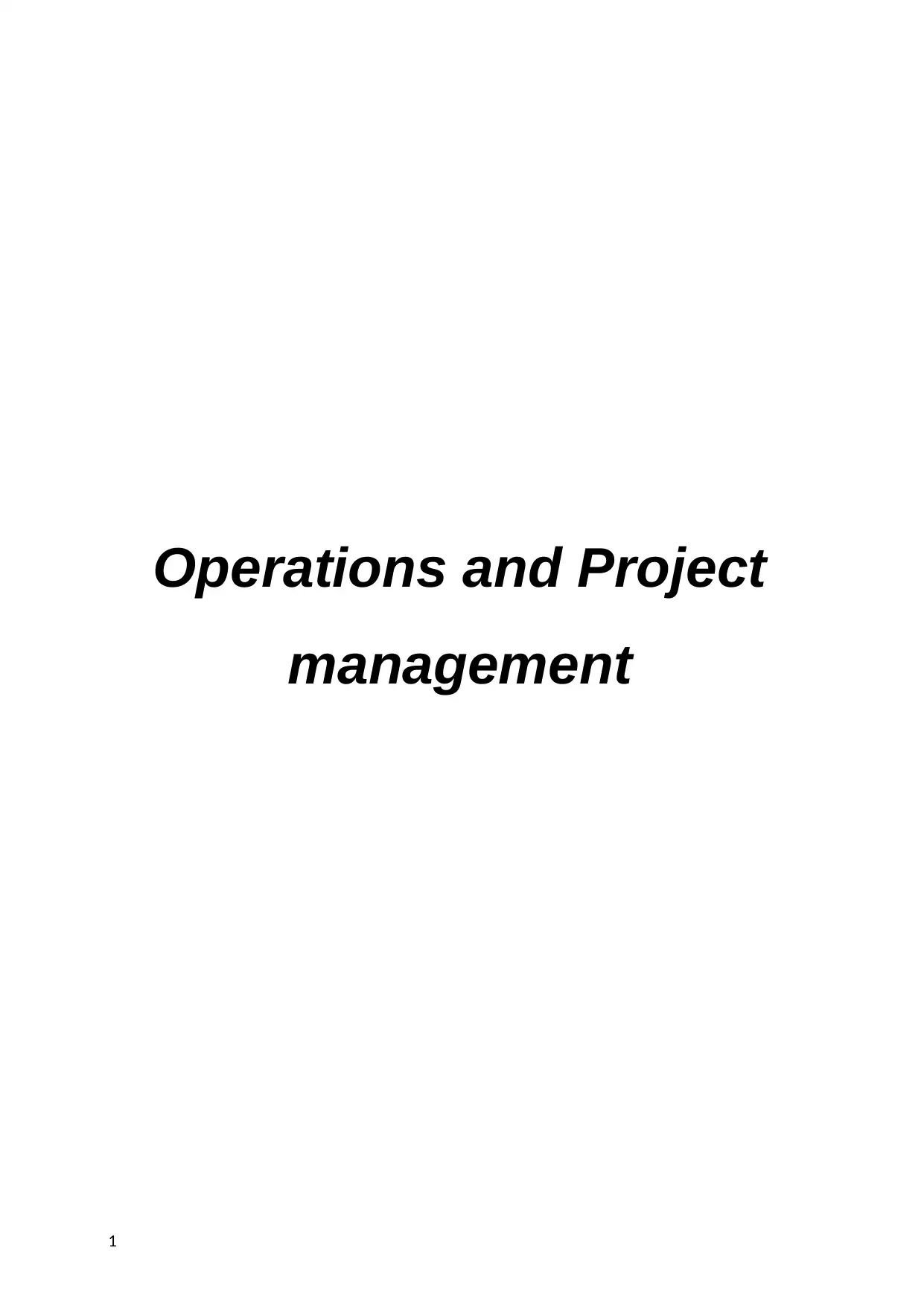
Operations and Project
management
1
management
1
Paraphrase This Document
Need a fresh take? Get an instant paraphrase of this document with our AI Paraphraser
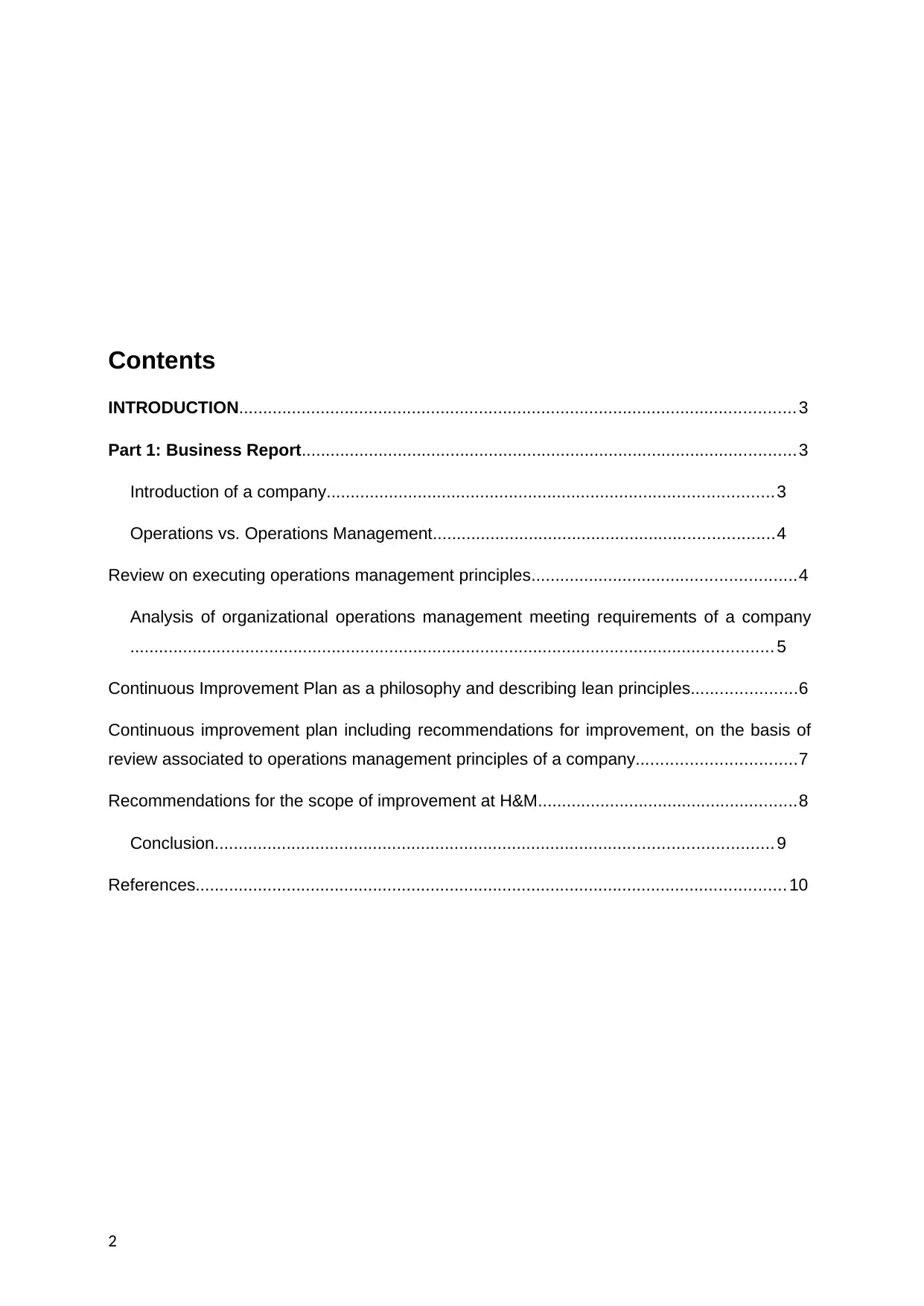
Contents
INTRODUCTION.................................................................................................................... 3
Part 1: Business Report.......................................................................................................3
Introduction of a company.............................................................................................3
Operations vs. Operations Management.......................................................................4
Review on executing operations management principles.......................................................4
Analysis of organizational operations management meeting requirements of a company
...................................................................................................................................... 5
Continuous Improvement Plan as a philosophy and describing lean principles......................6
Continuous improvement plan including recommendations for improvement, on the basis of
review associated to operations management principles of a company.................................7
Recommendations for the scope of improvement at H&M......................................................8
Conclusion.................................................................................................................... 9
References........................................................................................................................... 10
2
INTRODUCTION.................................................................................................................... 3
Part 1: Business Report.......................................................................................................3
Introduction of a company.............................................................................................3
Operations vs. Operations Management.......................................................................4
Review on executing operations management principles.......................................................4
Analysis of organizational operations management meeting requirements of a company
...................................................................................................................................... 5
Continuous Improvement Plan as a philosophy and describing lean principles......................6
Continuous improvement plan including recommendations for improvement, on the basis of
review associated to operations management principles of a company.................................7
Recommendations for the scope of improvement at H&M......................................................8
Conclusion.................................................................................................................... 9
References........................................................................................................................... 10
2
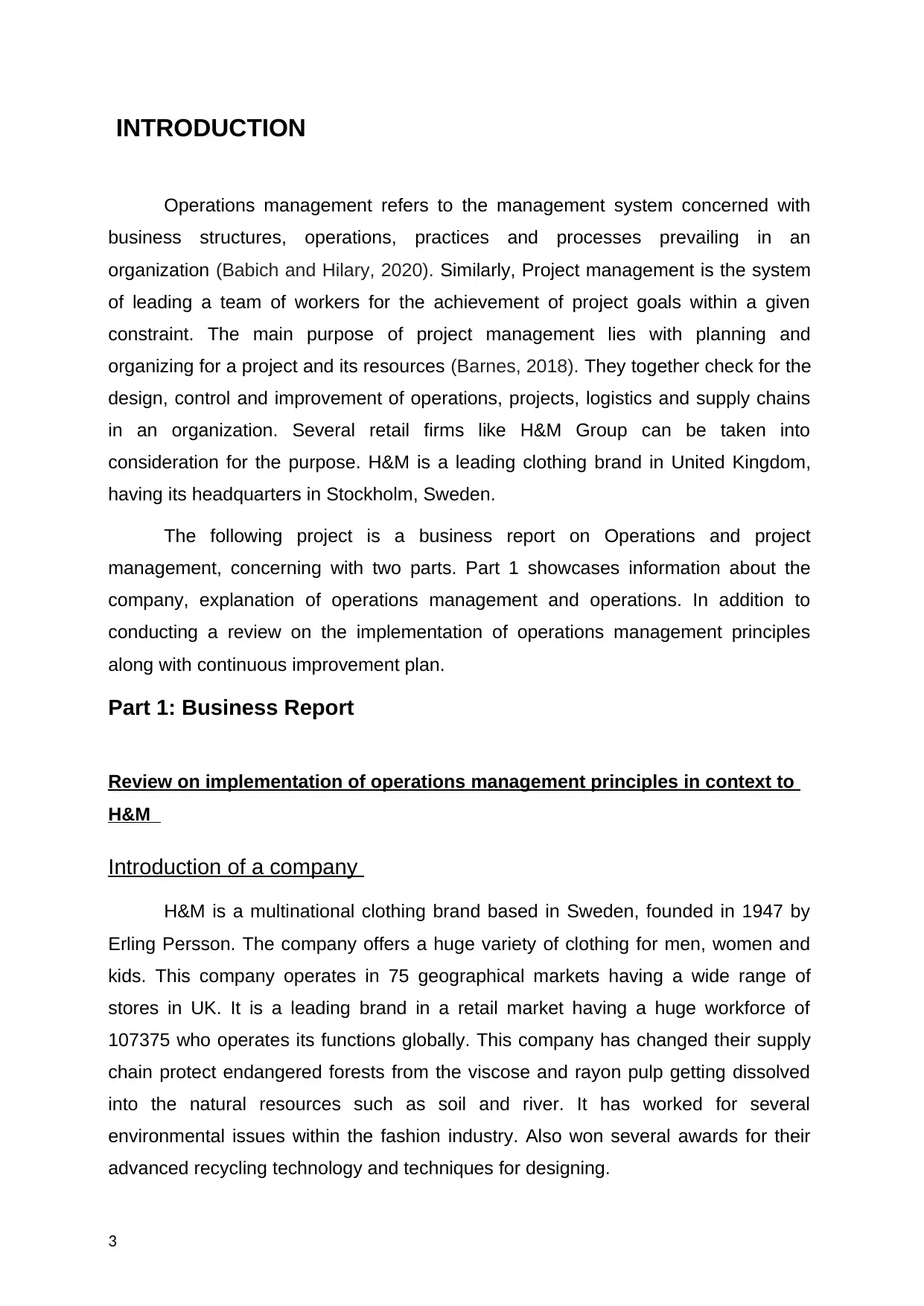
INTRODUCTION
Operations management refers to the management system concerned with
business structures, operations, practices and processes prevailing in an
organization (Babich and Hilary, 2020). Similarly, Project management is the system
of leading a team of workers for the achievement of project goals within a given
constraint. The main purpose of project management lies with planning and
organizing for a project and its resources (Barnes, 2018). They together check for the
design, control and improvement of operations, projects, logistics and supply chains
in an organization. Several retail firms like H&M Group can be taken into
consideration for the purpose. H&M is a leading clothing brand in United Kingdom,
having its headquarters in Stockholm, Sweden.
The following project is a business report on Operations and project
management, concerning with two parts. Part 1 showcases information about the
company, explanation of operations management and operations. In addition to
conducting a review on the implementation of operations management principles
along with continuous improvement plan.
Part 1: Business Report
Review on implementation of operations management principles in context to
H&M
Introduction of a company
H&M is a multinational clothing brand based in Sweden, founded in 1947 by
Erling Persson. The company offers a huge variety of clothing for men, women and
kids. This company operates in 75 geographical markets having a wide range of
stores in UK. It is a leading brand in a retail market having a huge workforce of
107375 who operates its functions globally. This company has changed their supply
chain protect endangered forests from the viscose and rayon pulp getting dissolved
into the natural resources such as soil and river. It has worked for several
environmental issues within the fashion industry. Also won several awards for their
advanced recycling technology and techniques for designing.
3
Operations management refers to the management system concerned with
business structures, operations, practices and processes prevailing in an
organization (Babich and Hilary, 2020). Similarly, Project management is the system
of leading a team of workers for the achievement of project goals within a given
constraint. The main purpose of project management lies with planning and
organizing for a project and its resources (Barnes, 2018). They together check for the
design, control and improvement of operations, projects, logistics and supply chains
in an organization. Several retail firms like H&M Group can be taken into
consideration for the purpose. H&M is a leading clothing brand in United Kingdom,
having its headquarters in Stockholm, Sweden.
The following project is a business report on Operations and project
management, concerning with two parts. Part 1 showcases information about the
company, explanation of operations management and operations. In addition to
conducting a review on the implementation of operations management principles
along with continuous improvement plan.
Part 1: Business Report
Review on implementation of operations management principles in context to
H&M
Introduction of a company
H&M is a multinational clothing brand based in Sweden, founded in 1947 by
Erling Persson. The company offers a huge variety of clothing for men, women and
kids. This company operates in 75 geographical markets having a wide range of
stores in UK. It is a leading brand in a retail market having a huge workforce of
107375 who operates its functions globally. This company has changed their supply
chain protect endangered forests from the viscose and rayon pulp getting dissolved
into the natural resources such as soil and river. It has worked for several
environmental issues within the fashion industry. Also won several awards for their
advanced recycling technology and techniques for designing.
3
⊘ This is a preview!⊘
Do you want full access?
Subscribe today to unlock all pages.

Trusted by 1+ million students worldwide
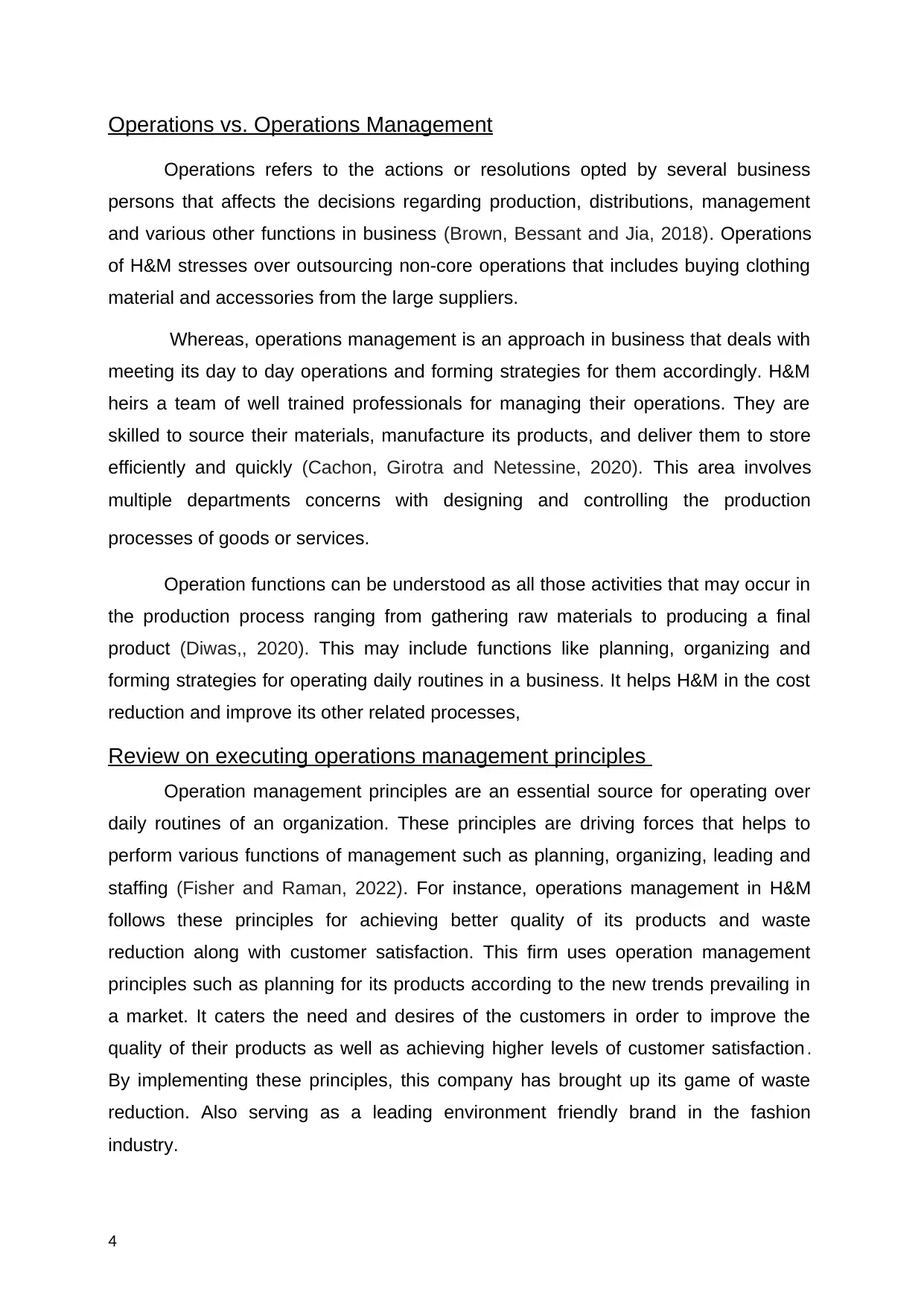
Operations vs. Operations Management
Operations refers to the actions or resolutions opted by several business
persons that affects the decisions regarding production, distributions, management
and various other functions in business (Brown, Bessant and Jia, 2018). Operations
of H&M stresses over outsourcing non-core operations that includes buying clothing
material and accessories from the large suppliers.
Whereas, operations management is an approach in business that deals with
meeting its day to day operations and forming strategies for them accordingly. H&M
heirs a team of well trained professionals for managing their operations. They are
skilled to source their materials, manufacture its products, and deliver them to store
efficiently and quickly (Cachon, Girotra and Netessine, 2020). This area involves
multiple departments concerns with designing and controlling the production
processes of goods or services.
Operation functions can be understood as all those activities that may occur in
the production process ranging from gathering raw materials to producing a final
product (Diwas,, 2020). This may include functions like planning, organizing and
forming strategies for operating daily routines in a business. It helps H&M in the cost
reduction and improve its other related processes,
Review on executing operations management principles
Operation management principles are an essential source for operating over
daily routines of an organization. These principles are driving forces that helps to
perform various functions of management such as planning, organizing, leading and
staffing (Fisher and Raman, 2022). For instance, operations management in H&M
follows these principles for achieving better quality of its products and waste
reduction along with customer satisfaction. This firm uses operation management
principles such as planning for its products according to the new trends prevailing in
a market. It caters the need and desires of the customers in order to improve the
quality of their products as well as achieving higher levels of customer satisfaction .
By implementing these principles, this company has brought up its game of waste
reduction. Also serving as a leading environment friendly brand in the fashion
industry.
4
Operations refers to the actions or resolutions opted by several business
persons that affects the decisions regarding production, distributions, management
and various other functions in business (Brown, Bessant and Jia, 2018). Operations
of H&M stresses over outsourcing non-core operations that includes buying clothing
material and accessories from the large suppliers.
Whereas, operations management is an approach in business that deals with
meeting its day to day operations and forming strategies for them accordingly. H&M
heirs a team of well trained professionals for managing their operations. They are
skilled to source their materials, manufacture its products, and deliver them to store
efficiently and quickly (Cachon, Girotra and Netessine, 2020). This area involves
multiple departments concerns with designing and controlling the production
processes of goods or services.
Operation functions can be understood as all those activities that may occur in
the production process ranging from gathering raw materials to producing a final
product (Diwas,, 2020). This may include functions like planning, organizing and
forming strategies for operating daily routines in a business. It helps H&M in the cost
reduction and improve its other related processes,
Review on executing operations management principles
Operation management principles are an essential source for operating over
daily routines of an organization. These principles are driving forces that helps to
perform various functions of management such as planning, organizing, leading and
staffing (Fisher and Raman, 2022). For instance, operations management in H&M
follows these principles for achieving better quality of its products and waste
reduction along with customer satisfaction. This firm uses operation management
principles such as planning for its products according to the new trends prevailing in
a market. It caters the need and desires of the customers in order to improve the
quality of their products as well as achieving higher levels of customer satisfaction .
By implementing these principles, this company has brought up its game of waste
reduction. Also serving as a leading environment friendly brand in the fashion
industry.
4
Paraphrase This Document
Need a fresh take? Get an instant paraphrase of this document with our AI Paraphraser
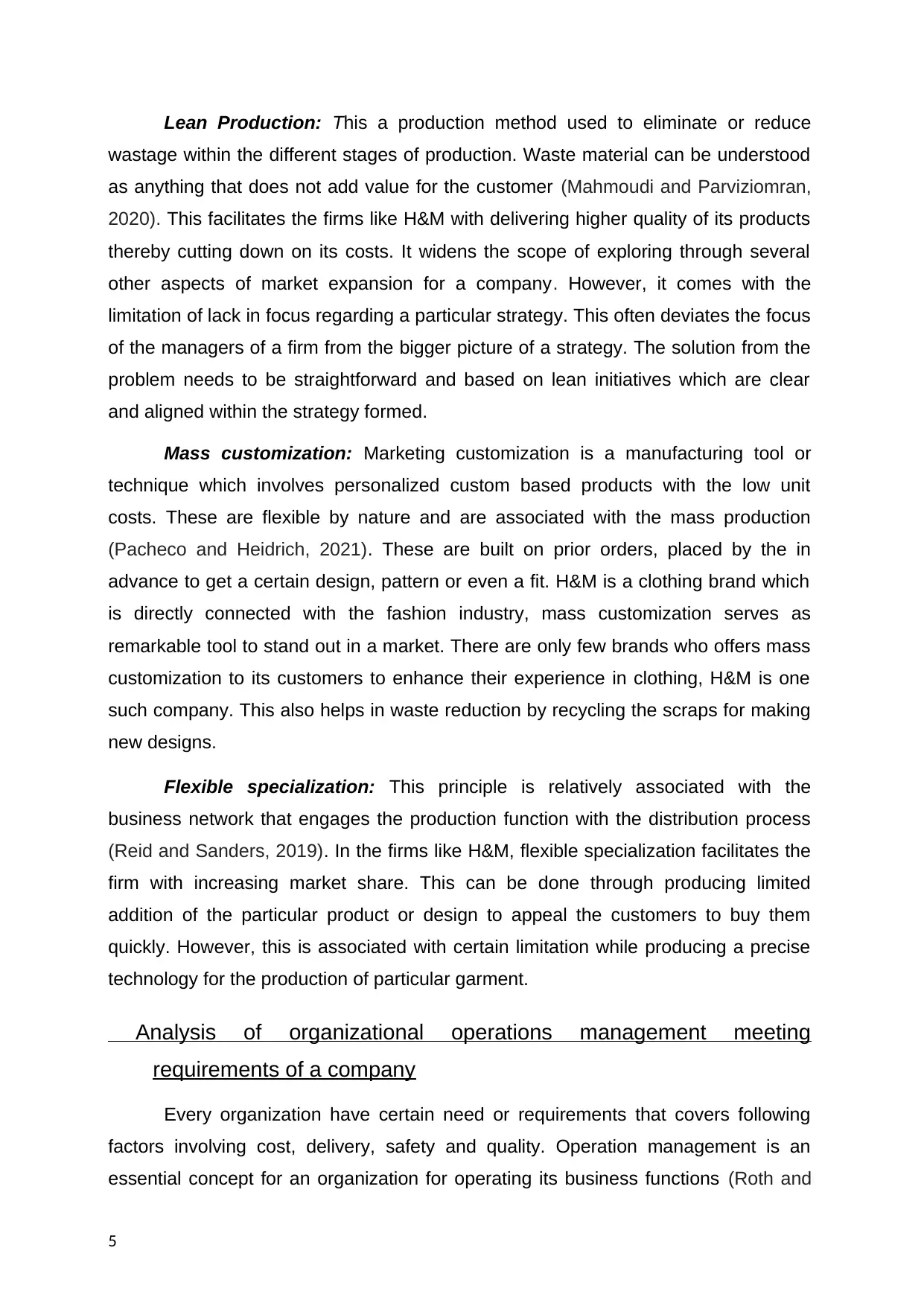
Lean Production: This a production method used to eliminate or reduce
wastage within the different stages of production. Waste material can be understood
as anything that does not add value for the customer (Mahmoudi and Parviziomran,
2020). This facilitates the firms like H&M with delivering higher quality of its products
thereby cutting down on its costs. It widens the scope of exploring through several
other aspects of market expansion for a company. However, it comes with the
limitation of lack in focus regarding a particular strategy. This often deviates the focus
of the managers of a firm from the bigger picture of a strategy. The solution from the
problem needs to be straightforward and based on lean initiatives which are clear
and aligned within the strategy formed.
Mass customization: Marketing customization is a manufacturing tool or
technique which involves personalized custom based products with the low unit
costs. These are flexible by nature and are associated with the mass production
(Pacheco and Heidrich, 2021). These are built on prior orders, placed by the in
advance to get a certain design, pattern or even a fit. H&M is a clothing brand which
is directly connected with the fashion industry, mass customization serves as
remarkable tool to stand out in a market. There are only few brands who offers mass
customization to its customers to enhance their experience in clothing, H&M is one
such company. This also helps in waste reduction by recycling the scraps for making
new designs.
Flexible specialization: This principle is relatively associated with the
business network that engages the production function with the distribution process
(Reid and Sanders, 2019). In the firms like H&M, flexible specialization facilitates the
firm with increasing market share. This can be done through producing limited
addition of the particular product or design to appeal the customers to buy them
quickly. However, this is associated with certain limitation while producing a precise
technology for the production of particular garment.
Analysis of organizational operations management meeting
requirements of a company
Every organization have certain need or requirements that covers following
factors involving cost, delivery, safety and quality. Operation management is an
essential concept for an organization for operating its business functions (Roth and
5
wastage within the different stages of production. Waste material can be understood
as anything that does not add value for the customer (Mahmoudi and Parviziomran,
2020). This facilitates the firms like H&M with delivering higher quality of its products
thereby cutting down on its costs. It widens the scope of exploring through several
other aspects of market expansion for a company. However, it comes with the
limitation of lack in focus regarding a particular strategy. This often deviates the focus
of the managers of a firm from the bigger picture of a strategy. The solution from the
problem needs to be straightforward and based on lean initiatives which are clear
and aligned within the strategy formed.
Mass customization: Marketing customization is a manufacturing tool or
technique which involves personalized custom based products with the low unit
costs. These are flexible by nature and are associated with the mass production
(Pacheco and Heidrich, 2021). These are built on prior orders, placed by the in
advance to get a certain design, pattern or even a fit. H&M is a clothing brand which
is directly connected with the fashion industry, mass customization serves as
remarkable tool to stand out in a market. There are only few brands who offers mass
customization to its customers to enhance their experience in clothing, H&M is one
such company. This also helps in waste reduction by recycling the scraps for making
new designs.
Flexible specialization: This principle is relatively associated with the
business network that engages the production function with the distribution process
(Reid and Sanders, 2019). In the firms like H&M, flexible specialization facilitates the
firm with increasing market share. This can be done through producing limited
addition of the particular product or design to appeal the customers to buy them
quickly. However, this is associated with certain limitation while producing a precise
technology for the production of particular garment.
Analysis of organizational operations management meeting
requirements of a company
Every organization have certain need or requirements that covers following
factors involving cost, delivery, safety and quality. Operation management is an
essential concept for an organization for operating its business functions (Roth and
5
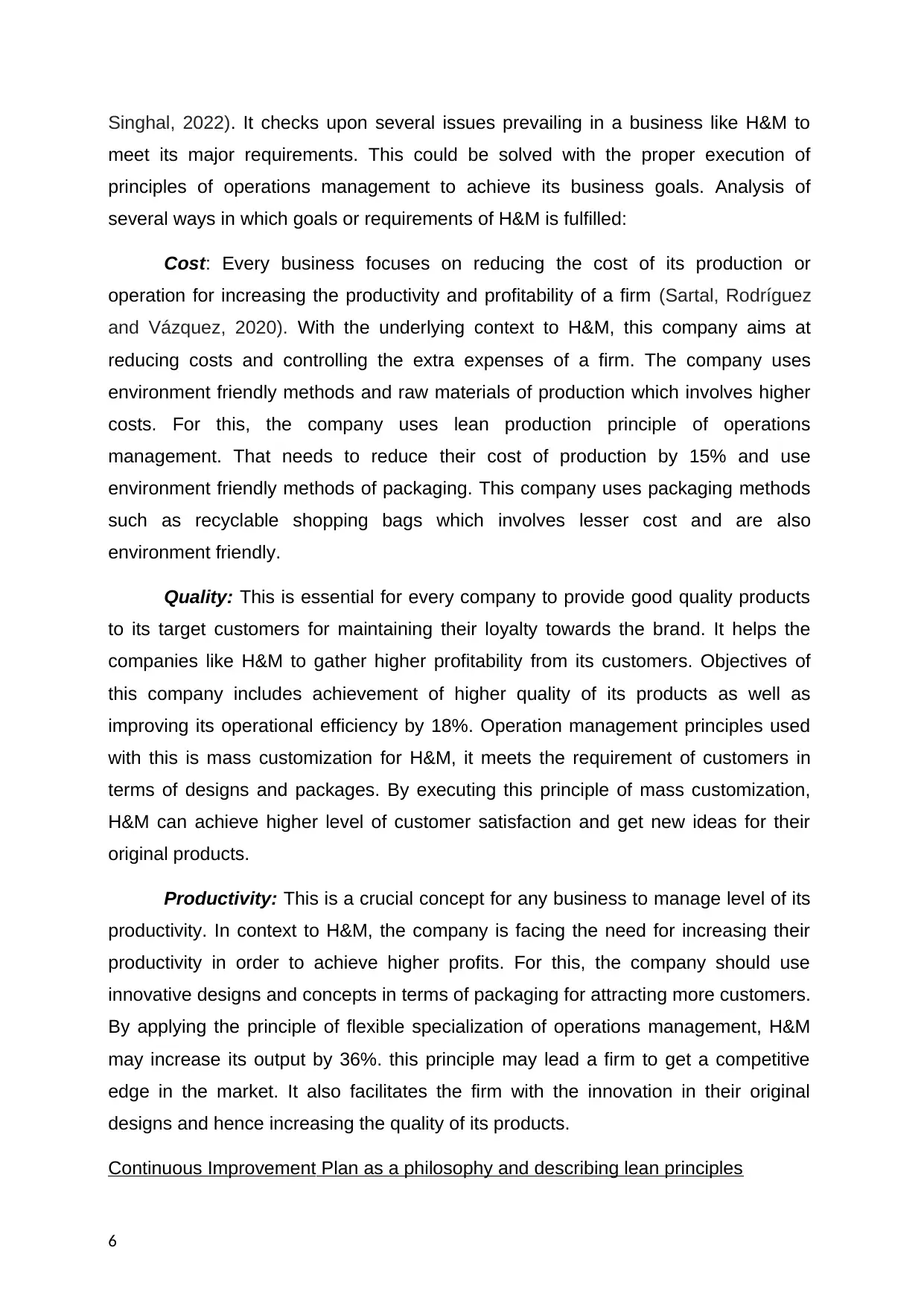
Singhal, 2022). It checks upon several issues prevailing in a business like H&M to
meet its major requirements. This could be solved with the proper execution of
principles of operations management to achieve its business goals. Analysis of
several ways in which goals or requirements of H&M is fulfilled:
Cost: Every business focuses on reducing the cost of its production or
operation for increasing the productivity and profitability of a firm (Sartal, Rodríguez
and Vázquez, 2020). With the underlying context to H&M, this company aims at
reducing costs and controlling the extra expenses of a firm. The company uses
environment friendly methods and raw materials of production which involves higher
costs. For this, the company uses lean production principle of operations
management. That needs to reduce their cost of production by 15% and use
environment friendly methods of packaging. This company uses packaging methods
such as recyclable shopping bags which involves lesser cost and are also
environment friendly.
Quality: This is essential for every company to provide good quality products
to its target customers for maintaining their loyalty towards the brand. It helps the
companies like H&M to gather higher profitability from its customers. Objectives of
this company includes achievement of higher quality of its products as well as
improving its operational efficiency by 18%. Operation management principles used
with this is mass customization for H&M, it meets the requirement of customers in
terms of designs and packages. By executing this principle of mass customization,
H&M can achieve higher level of customer satisfaction and get new ideas for their
original products.
Productivity: This is a crucial concept for any business to manage level of its
productivity. In context to H&M, the company is facing the need for increasing their
productivity in order to achieve higher profits. For this, the company should use
innovative designs and concepts in terms of packaging for attracting more customers.
By applying the principle of flexible specialization of operations management, H&M
may increase its output by 36%. this principle may lead a firm to get a competitive
edge in the market. It also facilitates the firm with the innovation in their original
designs and hence increasing the quality of its products.
Continuous Improvement Plan as a philosophy and describing lean principles
6
meet its major requirements. This could be solved with the proper execution of
principles of operations management to achieve its business goals. Analysis of
several ways in which goals or requirements of H&M is fulfilled:
Cost: Every business focuses on reducing the cost of its production or
operation for increasing the productivity and profitability of a firm (Sartal, Rodríguez
and Vázquez, 2020). With the underlying context to H&M, this company aims at
reducing costs and controlling the extra expenses of a firm. The company uses
environment friendly methods and raw materials of production which involves higher
costs. For this, the company uses lean production principle of operations
management. That needs to reduce their cost of production by 15% and use
environment friendly methods of packaging. This company uses packaging methods
such as recyclable shopping bags which involves lesser cost and are also
environment friendly.
Quality: This is essential for every company to provide good quality products
to its target customers for maintaining their loyalty towards the brand. It helps the
companies like H&M to gather higher profitability from its customers. Objectives of
this company includes achievement of higher quality of its products as well as
improving its operational efficiency by 18%. Operation management principles used
with this is mass customization for H&M, it meets the requirement of customers in
terms of designs and packages. By executing this principle of mass customization,
H&M can achieve higher level of customer satisfaction and get new ideas for their
original products.
Productivity: This is a crucial concept for any business to manage level of its
productivity. In context to H&M, the company is facing the need for increasing their
productivity in order to achieve higher profits. For this, the company should use
innovative designs and concepts in terms of packaging for attracting more customers.
By applying the principle of flexible specialization of operations management, H&M
may increase its output by 36%. this principle may lead a firm to get a competitive
edge in the market. It also facilitates the firm with the innovation in their original
designs and hence increasing the quality of its products.
Continuous Improvement Plan as a philosophy and describing lean principles
6
⊘ This is a preview!⊘
Do you want full access?
Subscribe today to unlock all pages.

Trusted by 1+ million students worldwide
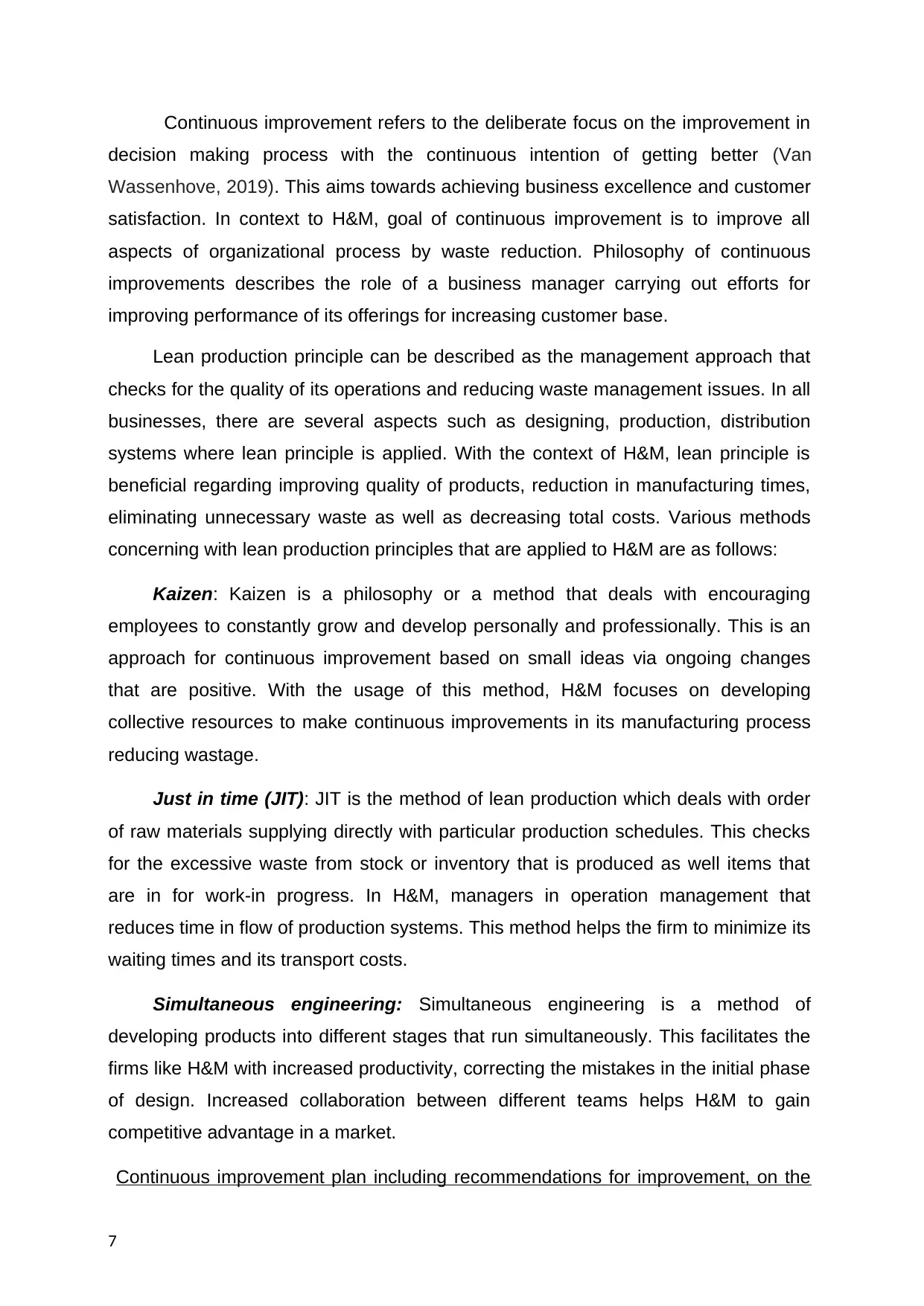
Continuous improvement refers to the deliberate focus on the improvement in
decision making process with the continuous intention of getting better (Van
Wassenhove, 2019). This aims towards achieving business excellence and customer
satisfaction. In context to H&M, goal of continuous improvement is to improve all
aspects of organizational process by waste reduction. Philosophy of continuous
improvements describes the role of a business manager carrying out efforts for
improving performance of its offerings for increasing customer base.
Lean production principle can be described as the management approach that
checks for the quality of its operations and reducing waste management issues. In all
businesses, there are several aspects such as designing, production, distribution
systems where lean principle is applied. With the context of H&M, lean principle is
beneficial regarding improving quality of products, reduction in manufacturing times,
eliminating unnecessary waste as well as decreasing total costs. Various methods
concerning with lean production principles that are applied to H&M are as follows:
Kaizen: Kaizen is a philosophy or a method that deals with encouraging
employees to constantly grow and develop personally and professionally. This is an
approach for continuous improvement based on small ideas via ongoing changes
that are positive. With the usage of this method, H&M focuses on developing
collective resources to make continuous improvements in its manufacturing process
reducing wastage.
Just in time (JIT): JIT is the method of lean production which deals with order
of raw materials supplying directly with particular production schedules. This checks
for the excessive waste from stock or inventory that is produced as well items that
are in for work-in progress. In H&M, managers in operation management that
reduces time in flow of production systems. This method helps the firm to minimize its
waiting times and its transport costs.
Simultaneous engineering: Simultaneous engineering is a method of
developing products into different stages that run simultaneously. This facilitates the
firms like H&M with increased productivity, correcting the mistakes in the initial phase
of design. Increased collaboration between different teams helps H&M to gain
competitive advantage in a market.
Continuous improvement plan including recommendations for improvement, on the
7
decision making process with the continuous intention of getting better (Van
Wassenhove, 2019). This aims towards achieving business excellence and customer
satisfaction. In context to H&M, goal of continuous improvement is to improve all
aspects of organizational process by waste reduction. Philosophy of continuous
improvements describes the role of a business manager carrying out efforts for
improving performance of its offerings for increasing customer base.
Lean production principle can be described as the management approach that
checks for the quality of its operations and reducing waste management issues. In all
businesses, there are several aspects such as designing, production, distribution
systems where lean principle is applied. With the context of H&M, lean principle is
beneficial regarding improving quality of products, reduction in manufacturing times,
eliminating unnecessary waste as well as decreasing total costs. Various methods
concerning with lean production principles that are applied to H&M are as follows:
Kaizen: Kaizen is a philosophy or a method that deals with encouraging
employees to constantly grow and develop personally and professionally. This is an
approach for continuous improvement based on small ideas via ongoing changes
that are positive. With the usage of this method, H&M focuses on developing
collective resources to make continuous improvements in its manufacturing process
reducing wastage.
Just in time (JIT): JIT is the method of lean production which deals with order
of raw materials supplying directly with particular production schedules. This checks
for the excessive waste from stock or inventory that is produced as well items that
are in for work-in progress. In H&M, managers in operation management that
reduces time in flow of production systems. This method helps the firm to minimize its
waiting times and its transport costs.
Simultaneous engineering: Simultaneous engineering is a method of
developing products into different stages that run simultaneously. This facilitates the
firms like H&M with increased productivity, correcting the mistakes in the initial phase
of design. Increased collaboration between different teams helps H&M to gain
competitive advantage in a market.
Continuous improvement plan including recommendations for improvement, on the
7
Paraphrase This Document
Need a fresh take? Get an instant paraphrase of this document with our AI Paraphraser
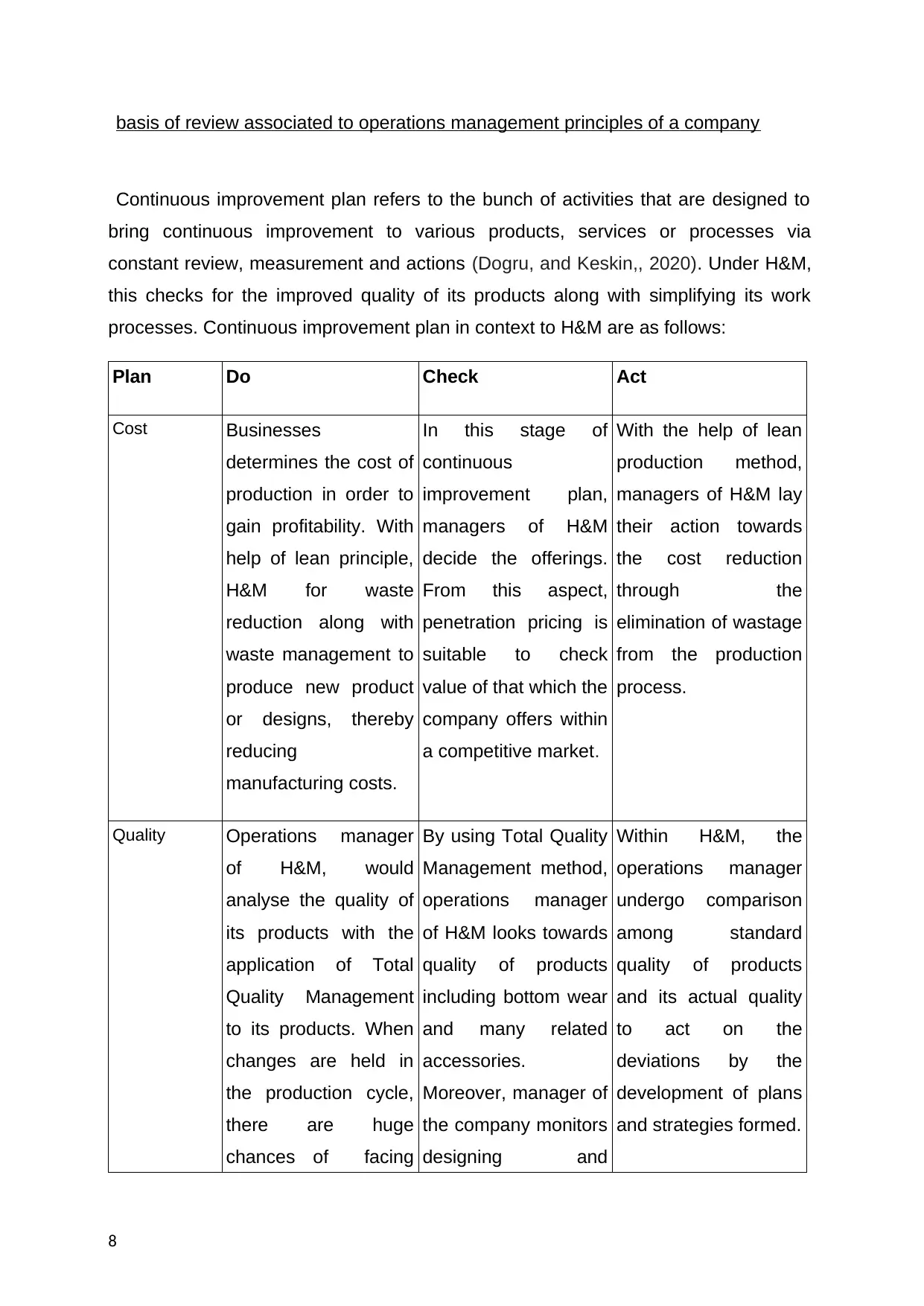
basis of review associated to operations management principles of a company
Continuous improvement plan refers to the bunch of activities that are designed to
bring continuous improvement to various products, services or processes via
constant review, measurement and actions (Dogru, and Keskin,, 2020). Under H&M,
this checks for the improved quality of its products along with simplifying its work
processes. Continuous improvement plan in context to H&M are as follows:
Plan Do Check Act
Cost Businesses
determines the cost of
production in order to
gain profitability. With
help of lean principle,
H&M for waste
reduction along with
waste management to
produce new product
or designs, thereby
reducing
manufacturing costs.
In this stage of
continuous
improvement plan,
managers of H&M
decide the offerings.
From this aspect,
penetration pricing is
suitable to check
value of that which the
company offers within
a competitive market.
With the help of lean
production method,
managers of H&M lay
their action towards
the cost reduction
through the
elimination of wastage
from the production
process.
Quality Operations manager
of H&M, would
analyse the quality of
its products with the
application of Total
Quality Management
to its products. When
changes are held in
the production cycle,
there are huge
chances of facing
By using Total Quality
Management method,
operations manager
of H&M looks towards
quality of products
including bottom wear
and many related
accessories.
Moreover, manager of
the company monitors
designing and
Within H&M, the
operations manager
undergo comparison
among standard
quality of products
and its actual quality
to act on the
deviations by the
development of plans
and strategies formed.
8
Continuous improvement plan refers to the bunch of activities that are designed to
bring continuous improvement to various products, services or processes via
constant review, measurement and actions (Dogru, and Keskin,, 2020). Under H&M,
this checks for the improved quality of its products along with simplifying its work
processes. Continuous improvement plan in context to H&M are as follows:
Plan Do Check Act
Cost Businesses
determines the cost of
production in order to
gain profitability. With
help of lean principle,
H&M for waste
reduction along with
waste management to
produce new product
or designs, thereby
reducing
manufacturing costs.
In this stage of
continuous
improvement plan,
managers of H&M
decide the offerings.
From this aspect,
penetration pricing is
suitable to check
value of that which the
company offers within
a competitive market.
With the help of lean
production method,
managers of H&M lay
their action towards
the cost reduction
through the
elimination of wastage
from the production
process.
Quality Operations manager
of H&M, would
analyse the quality of
its products with the
application of Total
Quality Management
to its products. When
changes are held in
the production cycle,
there are huge
chances of facing
By using Total Quality
Management method,
operations manager
of H&M looks towards
quality of products
including bottom wear
and many related
accessories.
Moreover, manager of
the company monitors
designing and
Within H&M, the
operations manager
undergo comparison
among standard
quality of products
and its actual quality
to act on the
deviations by the
development of plans
and strategies formed.
8
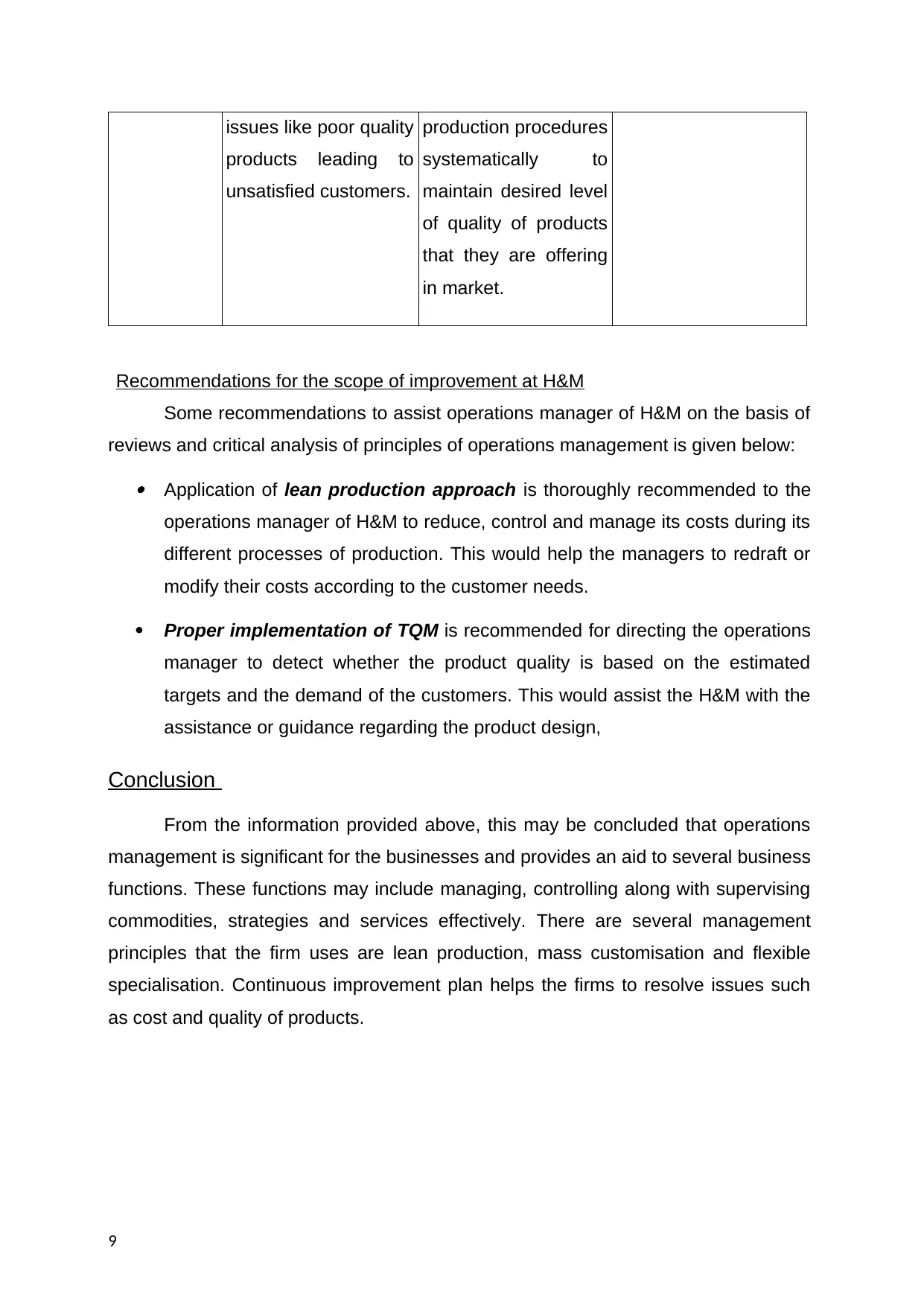
issues like poor quality
products leading to
unsatisfied customers.
production procedures
systematically to
maintain desired level
of quality of products
that they are offering
in market.
Recommendations for the scope of improvement at H&M
Some recommendations to assist operations manager of H&M on the basis of
reviews and critical analysis of principles of operations management is given below: Application of lean production approach is thoroughly recommended to the
operations manager of H&M to reduce, control and manage its costs during its
different processes of production. This would help the managers to redraft or
modify their costs according to the customer needs.
Proper implementation of TQM is recommended for directing the operations
manager to detect whether the product quality is based on the estimated
targets and the demand of the customers. This would assist the H&M with the
assistance or guidance regarding the product design,
Conclusion
From the information provided above, this may be concluded that operations
management is significant for the businesses and provides an aid to several business
functions. These functions may include managing, controlling along with supervising
commodities, strategies and services effectively. There are several management
principles that the firm uses are lean production, mass customisation and flexible
specialisation. Continuous improvement plan helps the firms to resolve issues such
as cost and quality of products.
9
products leading to
unsatisfied customers.
production procedures
systematically to
maintain desired level
of quality of products
that they are offering
in market.
Recommendations for the scope of improvement at H&M
Some recommendations to assist operations manager of H&M on the basis of
reviews and critical analysis of principles of operations management is given below: Application of lean production approach is thoroughly recommended to the
operations manager of H&M to reduce, control and manage its costs during its
different processes of production. This would help the managers to redraft or
modify their costs according to the customer needs.
Proper implementation of TQM is recommended for directing the operations
manager to detect whether the product quality is based on the estimated
targets and the demand of the customers. This would assist the H&M with the
assistance or guidance regarding the product design,
Conclusion
From the information provided above, this may be concluded that operations
management is significant for the businesses and provides an aid to several business
functions. These functions may include managing, controlling along with supervising
commodities, strategies and services effectively. There are several management
principles that the firm uses are lean production, mass customisation and flexible
specialisation. Continuous improvement plan helps the firms to resolve issues such
as cost and quality of products.
9
⊘ This is a preview!⊘
Do you want full access?
Subscribe today to unlock all pages.

Trusted by 1+ million students worldwide
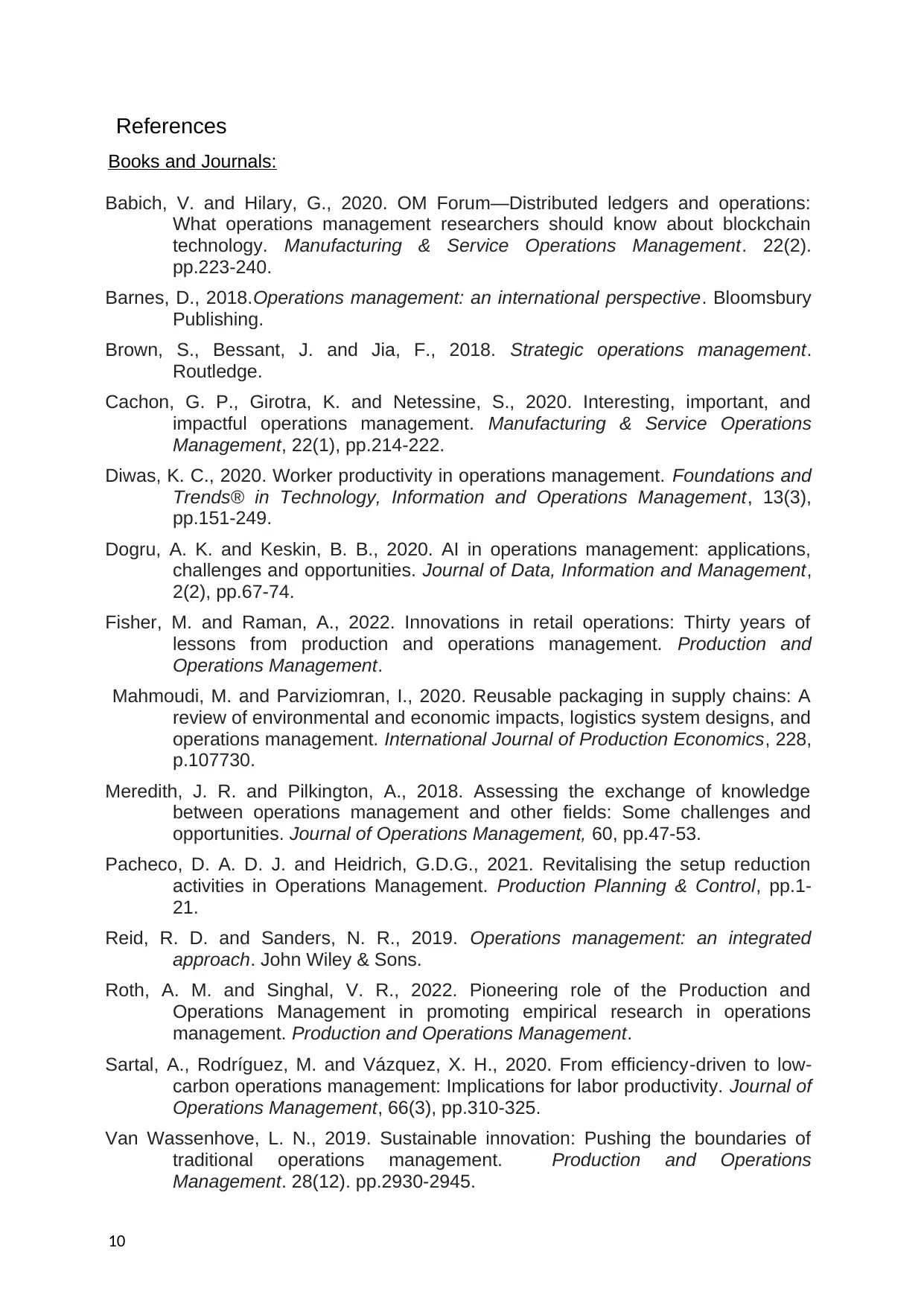
References
Books and Journals:
Babich, V. and Hilary, G., 2020. OM Forum—Distributed ledgers and operations:
What operations management researchers should know about blockchain
technology. Manufacturing & Service Operations Management. 22(2).
pp.223-240.
Barnes, D., 2018.Operations management: an international perspective. Bloomsbury
Publishing.
Brown, S., Bessant, J. and Jia, F., 2018. Strategic operations management.
Routledge.
Cachon, G. P., Girotra, K. and Netessine, S., 2020. Interesting, important, and
impactful operations management. Manufacturing & Service Operations
Management, 22(1), pp.214-222.
Diwas, K. C., 2020. Worker productivity in operations management. Foundations and
Trends® in Technology, Information and Operations Management, 13(3),
pp.151-249.
Dogru, A. K. and Keskin, B. B., 2020. AI in operations management: applications,
challenges and opportunities. Journal of Data, Information and Management,
2(2), pp.67-74.
Fisher, M. and Raman, A., 2022. Innovations in retail operations: Thirty years of
lessons from production and operations management. Production and
Operations Management.
Mahmoudi, M. and Parviziomran, I., 2020. Reusable packaging in supply chains: A
review of environmental and economic impacts, logistics system designs, and
operations management. International Journal of Production Economics, 228,
p.107730.
Meredith, J. R. and Pilkington, A., 2018. Assessing the exchange of knowledge
between operations management and other fields: Some challenges and
opportunities. Journal of Operations Management, 60, pp.47-53.
Pacheco, D. A. D. J. and Heidrich, G.D.G., 2021. Revitalising the setup reduction
activities in Operations Management. Production Planning & Control, pp.1-
21.
Reid, R. D. and Sanders, N. R., 2019. Operations management: an integrated
approach. John Wiley & Sons.
Roth, A. M. and Singhal, V. R., 2022. Pioneering role of the Production and
Operations Management in promoting empirical research in operations
management. Production and Operations Management.
Sartal, A., Rodríguez, M. and Vázquez, X. H., 2020. From efficiency‐driven to low‐
carbon operations management: Implications for labor productivity. Journal of
Operations Management, 66(3), pp.310-325.
Van Wassenhove, L. N., 2019. Sustainable innovation: Pushing the boundaries of
traditional operations management. Production and Operations
Management. 28(12). pp.2930-2945.
10
Books and Journals:
Babich, V. and Hilary, G., 2020. OM Forum—Distributed ledgers and operations:
What operations management researchers should know about blockchain
technology. Manufacturing & Service Operations Management. 22(2).
pp.223-240.
Barnes, D., 2018.Operations management: an international perspective. Bloomsbury
Publishing.
Brown, S., Bessant, J. and Jia, F., 2018. Strategic operations management.
Routledge.
Cachon, G. P., Girotra, K. and Netessine, S., 2020. Interesting, important, and
impactful operations management. Manufacturing & Service Operations
Management, 22(1), pp.214-222.
Diwas, K. C., 2020. Worker productivity in operations management. Foundations and
Trends® in Technology, Information and Operations Management, 13(3),
pp.151-249.
Dogru, A. K. and Keskin, B. B., 2020. AI in operations management: applications,
challenges and opportunities. Journal of Data, Information and Management,
2(2), pp.67-74.
Fisher, M. and Raman, A., 2022. Innovations in retail operations: Thirty years of
lessons from production and operations management. Production and
Operations Management.
Mahmoudi, M. and Parviziomran, I., 2020. Reusable packaging in supply chains: A
review of environmental and economic impacts, logistics system designs, and
operations management. International Journal of Production Economics, 228,
p.107730.
Meredith, J. R. and Pilkington, A., 2018. Assessing the exchange of knowledge
between operations management and other fields: Some challenges and
opportunities. Journal of Operations Management, 60, pp.47-53.
Pacheco, D. A. D. J. and Heidrich, G.D.G., 2021. Revitalising the setup reduction
activities in Operations Management. Production Planning & Control, pp.1-
21.
Reid, R. D. and Sanders, N. R., 2019. Operations management: an integrated
approach. John Wiley & Sons.
Roth, A. M. and Singhal, V. R., 2022. Pioneering role of the Production and
Operations Management in promoting empirical research in operations
management. Production and Operations Management.
Sartal, A., Rodríguez, M. and Vázquez, X. H., 2020. From efficiency‐driven to low‐
carbon operations management: Implications for labor productivity. Journal of
Operations Management, 66(3), pp.310-325.
Van Wassenhove, L. N., 2019. Sustainable innovation: Pushing the boundaries of
traditional operations management. Production and Operations
Management. 28(12). pp.2930-2945.
10
Paraphrase This Document
Need a fresh take? Get an instant paraphrase of this document with our AI Paraphraser
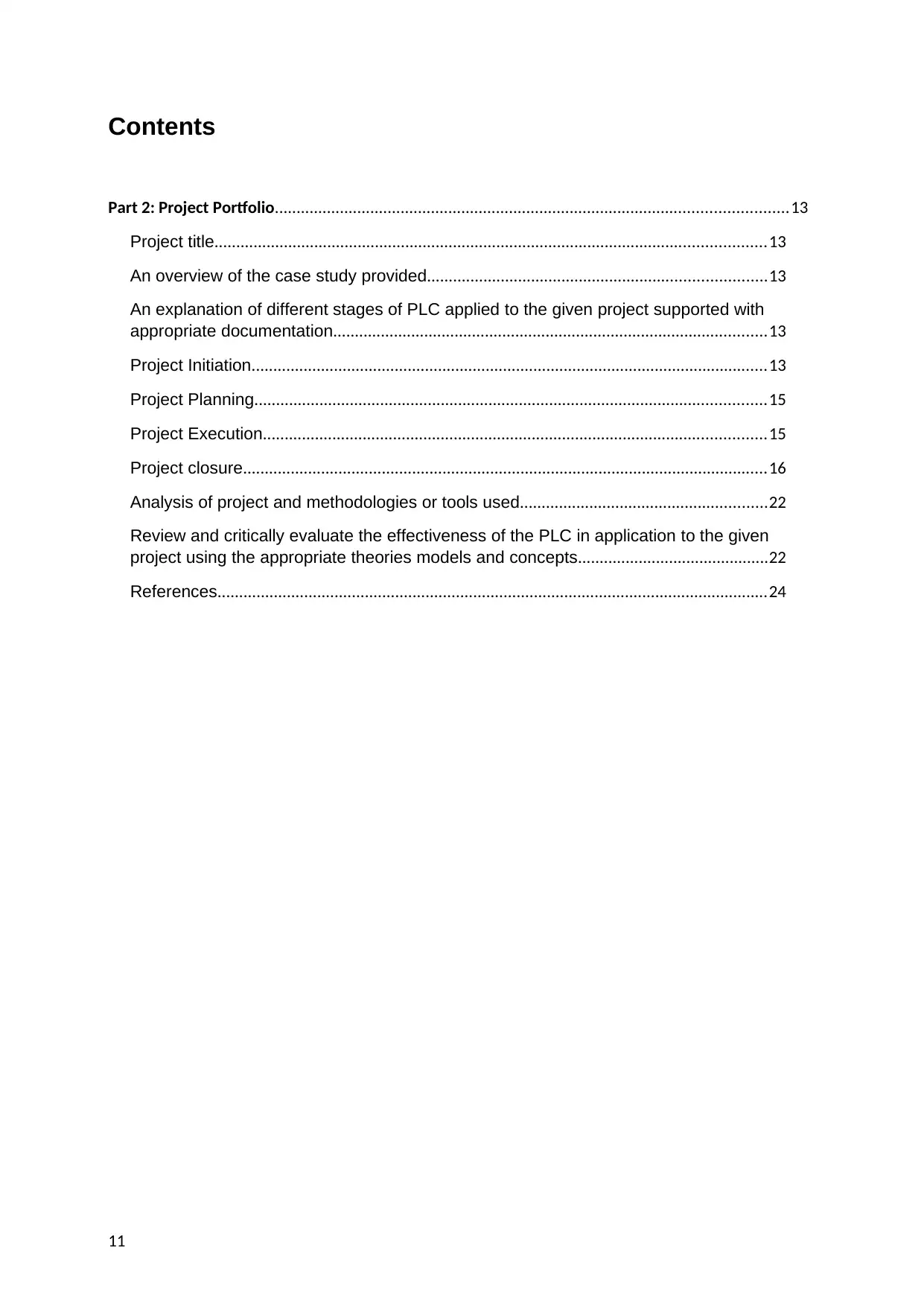
Contents
Part 2: Project Portfolio......................................................................................................................13
Project title...............................................................................................................................13
An overview of the case study provided..............................................................................13
An explanation of different stages of PLC applied to the given project supported with
appropriate documentation....................................................................................................13
Project Initiation.......................................................................................................................13
Project Planning......................................................................................................................15
Project Execution....................................................................................................................15
Project closure.........................................................................................................................16
Analysis of project and methodologies or tools used.........................................................22
Review and critically evaluate the effectiveness of the PLC in application to the given
project using the appropriate theories models and concepts............................................22
References...............................................................................................................................24
11
Part 2: Project Portfolio......................................................................................................................13
Project title...............................................................................................................................13
An overview of the case study provided..............................................................................13
An explanation of different stages of PLC applied to the given project supported with
appropriate documentation....................................................................................................13
Project Initiation.......................................................................................................................13
Project Planning......................................................................................................................15
Project Execution....................................................................................................................15
Project closure.........................................................................................................................16
Analysis of project and methodologies or tools used.........................................................22
Review and critically evaluate the effectiveness of the PLC in application to the given
project using the appropriate theories models and concepts............................................22
References...............................................................................................................................24
11
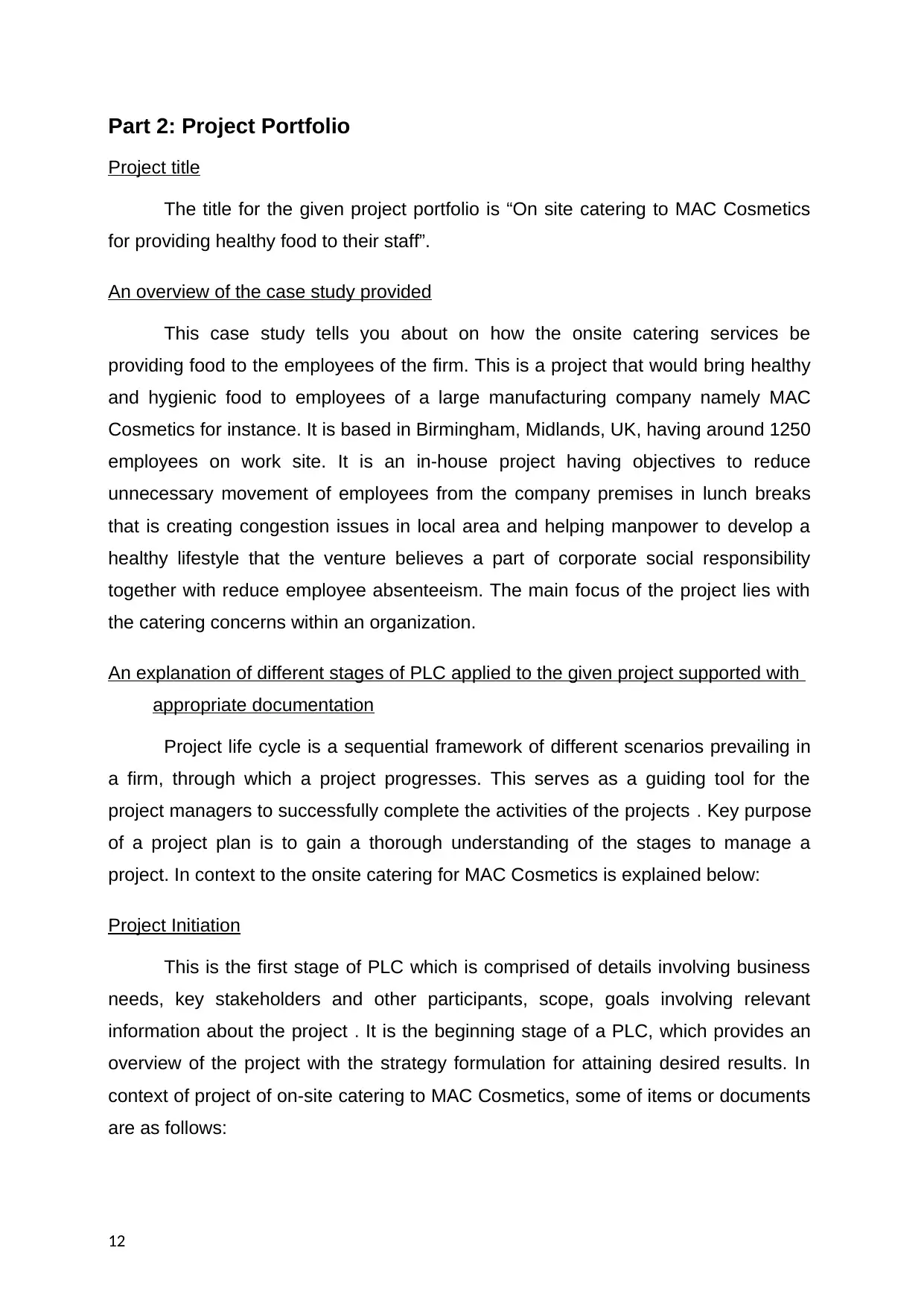
Part 2: Project Portfolio
Project title
The title for the given project portfolio is “On site catering to MAC Cosmetics
for providing healthy food to their staff”.
An overview of the case study provided
This case study tells you about on how the onsite catering services be
providing food to the employees of the firm. This is a project that would bring healthy
and hygienic food to employees of a large manufacturing company namely MAC
Cosmetics for instance. It is based in Birmingham, Midlands, UK, having around 1250
employees on work site. It is an in-house project having objectives to reduce
unnecessary movement of employees from the company premises in lunch breaks
that is creating congestion issues in local area and helping manpower to develop a
healthy lifestyle that the venture believes a part of corporate social responsibility
together with reduce employee absenteeism. The main focus of the project lies with
the catering concerns within an organization.
An explanation of different stages of PLC applied to the given project supported with
appropriate documentation
Project life cycle is a sequential framework of different scenarios prevailing in
a firm, through which a project progresses. This serves as a guiding tool for the
project managers to successfully complete the activities of the projects . Key purpose
of a project plan is to gain a thorough understanding of the stages to manage a
project. In context to the onsite catering for MAC Cosmetics is explained below:
Project Initiation
This is the first stage of PLC which is comprised of details involving business
needs, key stakeholders and other participants, scope, goals involving relevant
information about the project . It is the beginning stage of a PLC, which provides an
overview of the project with the strategy formulation for attaining desired results. In
context of project of on-site catering to MAC Cosmetics, some of items or documents
are as follows:
12
Project title
The title for the given project portfolio is “On site catering to MAC Cosmetics
for providing healthy food to their staff”.
An overview of the case study provided
This case study tells you about on how the onsite catering services be
providing food to the employees of the firm. This is a project that would bring healthy
and hygienic food to employees of a large manufacturing company namely MAC
Cosmetics for instance. It is based in Birmingham, Midlands, UK, having around 1250
employees on work site. It is an in-house project having objectives to reduce
unnecessary movement of employees from the company premises in lunch breaks
that is creating congestion issues in local area and helping manpower to develop a
healthy lifestyle that the venture believes a part of corporate social responsibility
together with reduce employee absenteeism. The main focus of the project lies with
the catering concerns within an organization.
An explanation of different stages of PLC applied to the given project supported with
appropriate documentation
Project life cycle is a sequential framework of different scenarios prevailing in
a firm, through which a project progresses. This serves as a guiding tool for the
project managers to successfully complete the activities of the projects . Key purpose
of a project plan is to gain a thorough understanding of the stages to manage a
project. In context to the onsite catering for MAC Cosmetics is explained below:
Project Initiation
This is the first stage of PLC which is comprised of details involving business
needs, key stakeholders and other participants, scope, goals involving relevant
information about the project . It is the beginning stage of a PLC, which provides an
overview of the project with the strategy formulation for attaining desired results. In
context of project of on-site catering to MAC Cosmetics, some of items or documents
are as follows:
12
⊘ This is a preview!⊘
Do you want full access?
Subscribe today to unlock all pages.

Trusted by 1+ million students worldwide
1 out of 24
Related Documents
Your All-in-One AI-Powered Toolkit for Academic Success.
+13062052269
info@desklib.com
Available 24*7 on WhatsApp / Email
![[object Object]](/_next/static/media/star-bottom.7253800d.svg)
Unlock your academic potential
Copyright © 2020–2025 A2Z Services. All Rights Reserved. Developed and managed by ZUCOL.




